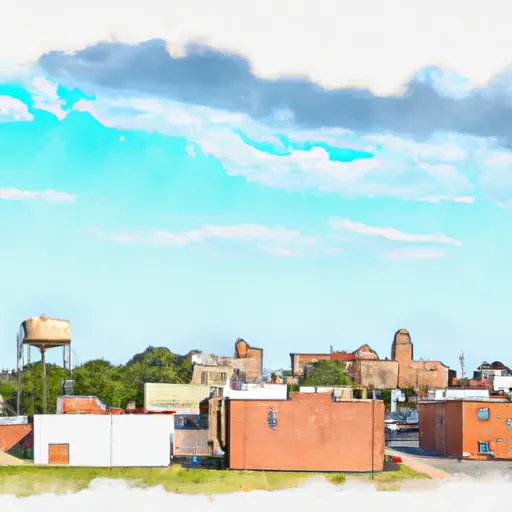-
 Snoflo Premium
Snoflo Premium
Get unlimited access to all our content
With no Ad interruptions! - Start Your Free Trial Login with existing account
Wardville
Eden Index
Climate
8.3
•
Recreation
0.3
•
Community
•
Safeguard
3.4/10

Wardville, Oklahoma is a small town located in Coal County, known for its unique climate and abundant outdoor recreation opportunities. The region experiences a humid subtropical climate, characterized by hot summers and mild winters. Summers are typically hot and humid, with temperatures averaging around 90°F, while winters are generally mild with temperatures ranging from 40-60°F.
Wardville is surrounded by numerous lakes and water bodies, making it a great destination for water enthusiasts. With the presence of Lake Wister and several nearby rivers, water-based activities like fishing, boating, and swimming are popular in the area. The hydrology constituents of the region are rich, providing a diverse range of fish species, including bass, catfish, and crappie.
In addition to water-based activities, Wardville offers several outdoor recreation opportunities. The nearby Ouachita National Forest provides excellent hiking and camping opportunities, allowing visitors to explore the natural beauty of the area. Hunting is also popular in the surrounding forests, providing opportunities for deer, turkey, and small game hunting.
Overall, Wardville, Oklahoma presents an inviting climate, diverse hydrology constituents, and a range of outdoor recreation opportunities, making it an ideal destination for nature enthusiasts and outdoor adventurers alike.
What is the Eden Index?
The Snoflo Eden Index serves as a comprehensive rating system for regions, evaluating their desirability through a holistic assessment of climate health, outdoor recreation opportunities, and natural disaster risk, acknowledging the profound impact of these factors on livability and well-being.
Climate Health Indicator (CHI): 8.3
Wardville receives approximately
1116mm of rain per year,
with humidity levels near 83%
and air temperatures averaging around
17°C.
Wardville has a plant hardyness factor of
7, meaning
plants and agriculture in this region tend to thrive during the non-winter months.
By considering the ideal temperature range, reliable water supplies, clean air, and stable seasonal rain or snowpacks, the Climate Health Indicator (CHI) underscores the significance of a healthy climate as the foundation for quality living.
A healthy climate is paramount for ensuring a high quality of life and livability in a region, fostering both physical well-being and environmental harmony. This can be characterized by ideal temperatures, reliable access to water supplies, clean air, and consistent seasonal rain or snowpacks.
Weather Forecast
Streamflow Conditions
Red-Little
Area Rivers
Red-Little
Snowpack Depths
Red-Little
Reservoir Storage Capacity
Red-Little
Groundwater Levels
Recreational Opportunity Index (ROI): 0.3
The Recreational Opportunity Index (ROI) recognizes the value of outdoor recreational options, such as parks, hiking trails, camping sites, and fishing spots, while acknowledging that climate plays a pivotal role in ensuring the comfort and consistency of these experiences.
Access to outdoor recreational opportunities, encompassing activities such as parks, hiking, camping, and fishing, is crucial for overall well-being, and the climate plays a pivotal role in enabling and enhancing these experiences, ensuring that individuals can engage in nature-based activities comfortably and consistently.
Camping Areas
| Campground | Campsites | Reservations | Toilets | Showers | Elevation |
|---|---|---|---|---|---|
| Murphys Meadow Military - McAlester | None | 725 ft | |||
| Wind Point Park | 135 | 457 ft | |||
| Bonham State Park | 21 | 613 ft | |||
| Lake McAlester | None | 626 ft | |||
| McGee Creek State Park | None | 684 ft | |||
| Lake Tawakoni State Park | 78 | 457 ft |
Nearby Fishing
Catastrophe Safeguard Index (CSI):
The Catastrophe Safeguard Index (CSI) recognizes that natural disaster risk, encompassing floods, fires, hurricanes, and tornadoes, can drastically affect safety and the overall appeal of an area.
The level of natural disaster risk in a region significantly affects safety and the overall livability, with climate change amplifying these risks by potentially increasing the frequency and intensity of events like floods, fires, hurricanes, and tornadoes, thereby posing substantial challenges to community resilience and well-being.
Community Resilience Indicator (CRI):
The Community Resilience Indicator (CRI) recognizes that education, healthcare, and socioeconomics are crucial to the well-being of a region. The CRI acknowledges the profound impact of these elements on residents' overall quality of life. By evaluating educational resources, healthcare accessibility, and economic inclusivity, the index captures the essential aspects that contribute to a thriving community, fostering resident satisfaction, equity, and social cohesion.

